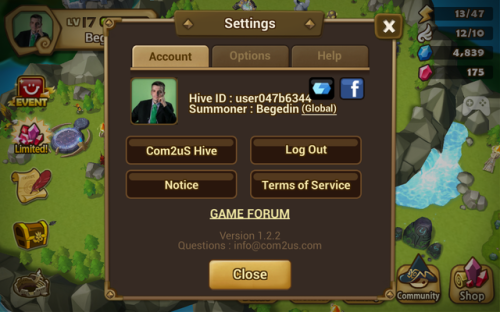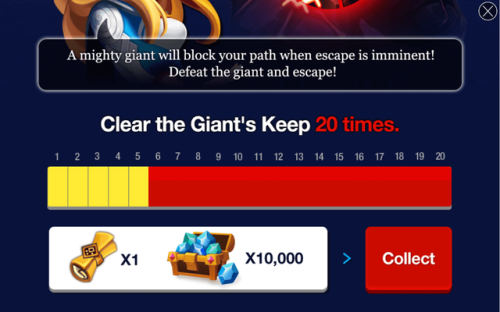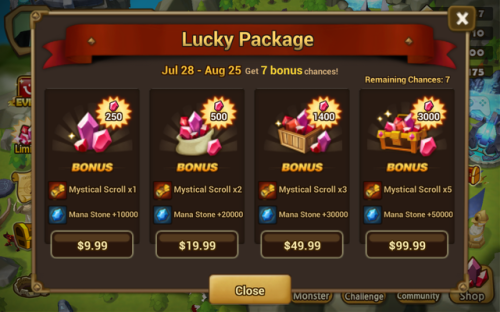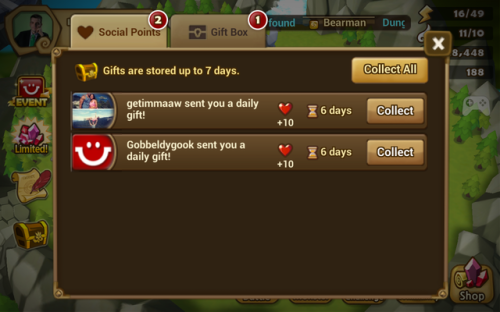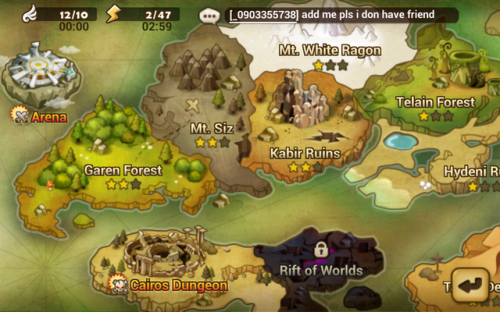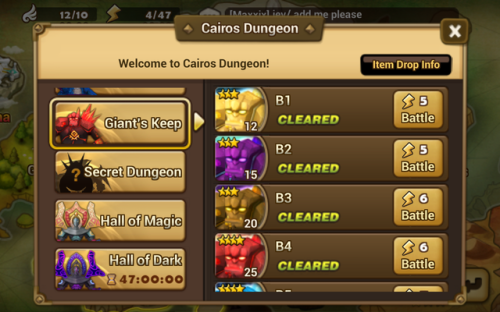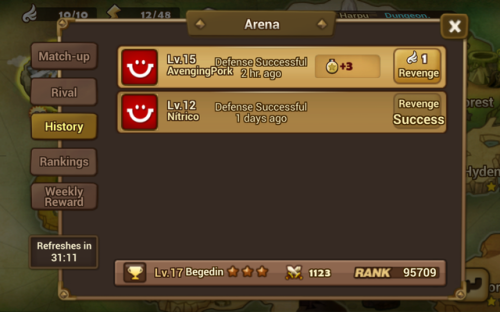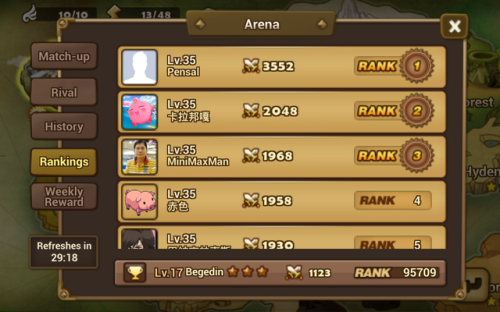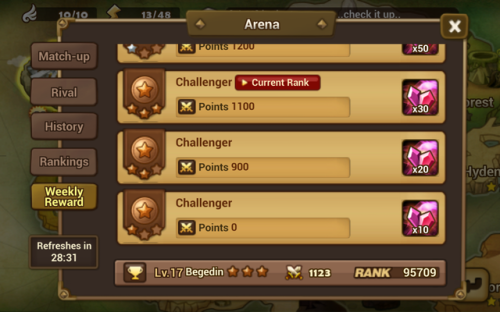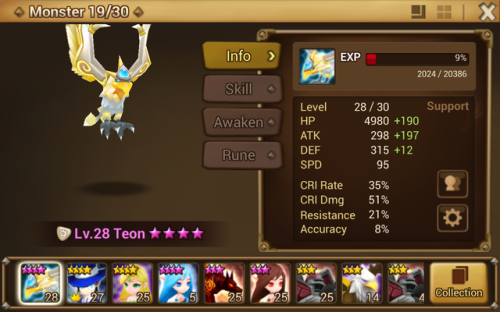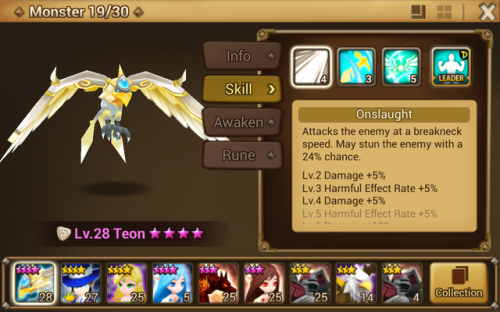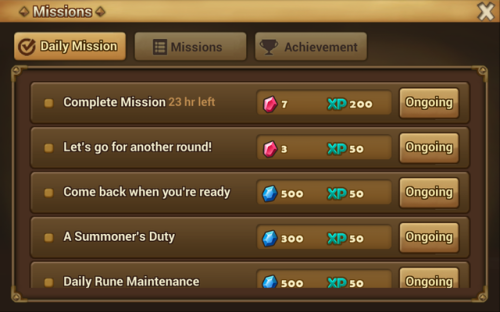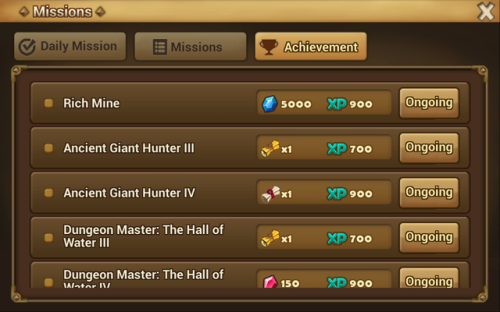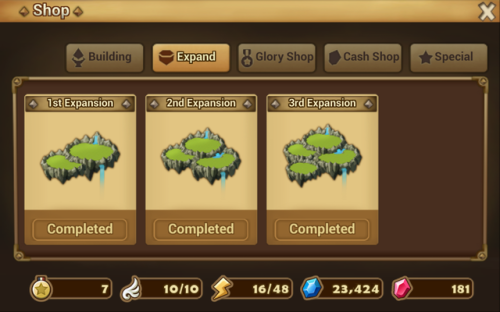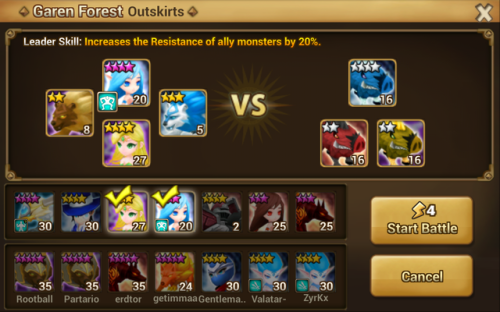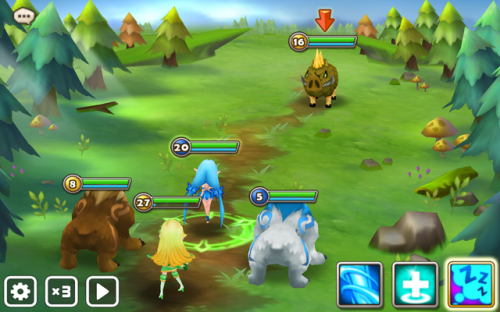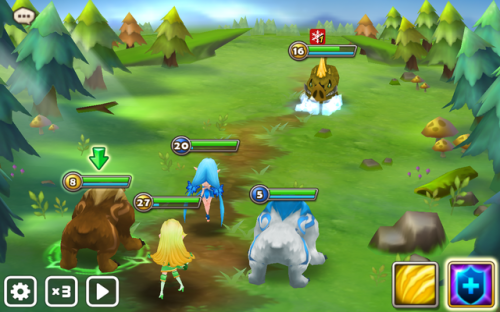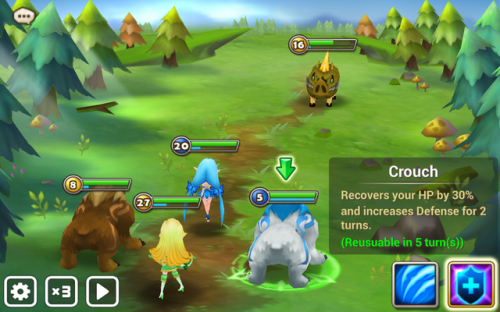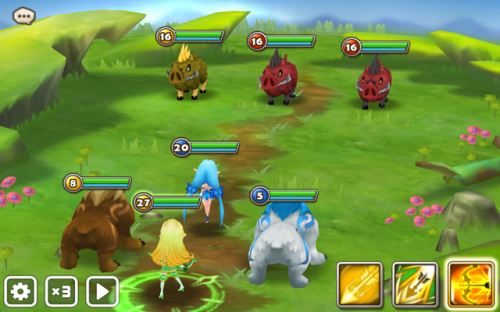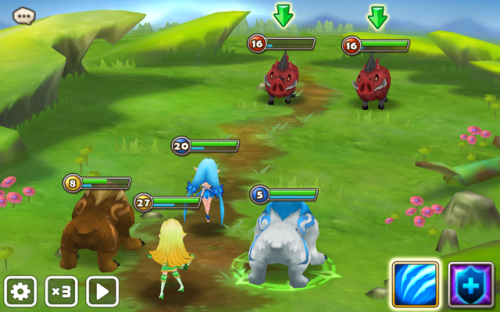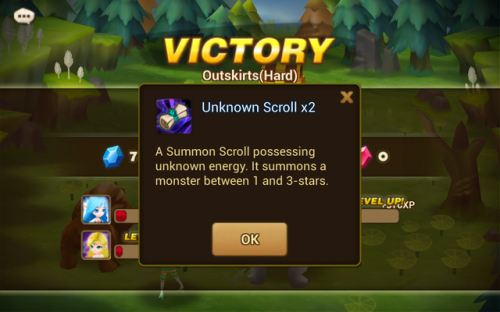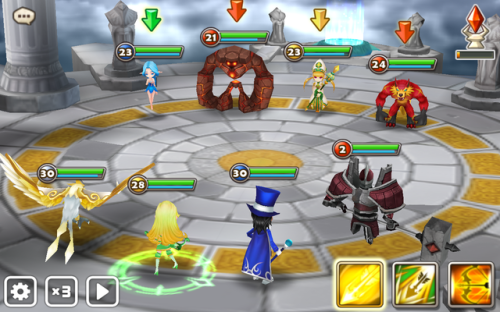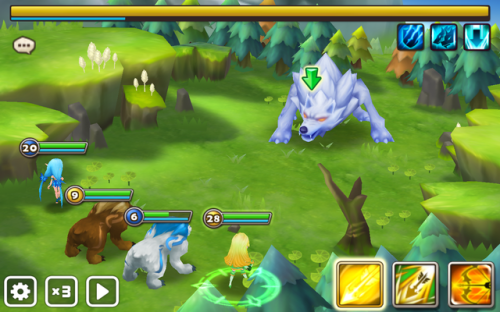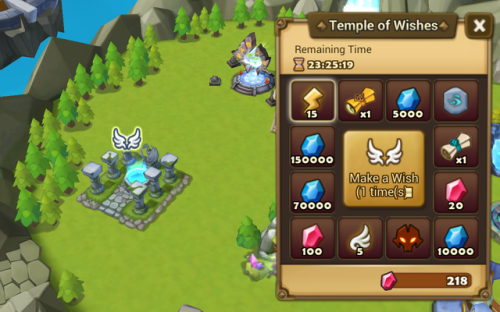If you read my postings, you’re probably thinking I have an issue with most mobile games and you’re right. I think most mobile games are horrible in the game department and even worse in let’s trick the humans into playing by using skinner box mechanics department. I’ve played World of Warcraft for a long time and it has made me observant of the typical mechanics that trick the player into thinking they’re having fun instead of actually being fun. The thing is, I see this and I hate this, but I still end up playing such a game for far too long. I’m pretty sure Summoners War is one such game. Still, as usual, I’ll give an overview of the game.
What is Summoners War
As the title says, it’s basically Pokemon Lite. You buy, collect, find and grind up monsters. Then you train them and fight them in levels of ever-increasing difficulty in order to find, collect, buy and grind up even stronger monsters. There’s an online aspect and there’s a PVP arena, but mostly it’s just battles and grinding for currency.
The game looks pretty great and it plays smoothly. There was obviously a lot of polish put into the visuals of it. However, the actual game part is, as usual for a mobile game, relatively shallow. Not as shallow as most mobile games, true, but still relatively shallow.
How does it play?
OK, this is the big part. I’m hoping your connection can handle the screenshots.
First of all, the game is online-only. There is no way to play it without an internet connection.
Once you get past an unusually lengthy loading/connecting screen, you’re taken to the main game screen – a view of your floating island.
Main game screen
This is your home base and the place from which you get to all other parts of the game.
You start out with just a single section, the one you see at the top, but you soon get to buy up to three more sections. You only see three total on the screenshot, but there’s one more to the south, bellow two lower ones.
Other than room for building and an achievement, the other three sections don’t provide anything else.
Let’s analyze the screen for a bit.
The top left has my profile picture, username and level. Clicking on this part of the interface opens the setings menu.
The settings are mostly straightforward. You can connect to various social profiles here, access the help section for the game or change various in-game options such as music, power saving, graphic detail, etc.
The notification/objective area
Bellow the profile picture, there are buttons for quests, social things and events. They work sort of like notifications, except they don’t go away until you fulfill whatever it is they ask of you, or the related event is over.
The red square smiley face with Event written under it takes you to an in-game web page for whatever the current event is. There, you can read up on what you get to do and collect rewards as you fulfill event requirements. As I’m writing this, there are two events active.
The simpler one simply makes all the special elemental dungeons of the game, of which a different one is available each day, available at once.
The slightly more complex one actually has an objective. First, you need need 100 dungeon victories and you receive prizes at 20, 40, 70 and 100 clears.
Once you’re done with that, another part of the event unlocks, where you have to clear any Giant’s Keep dungeon level 20 times for one more prize. I’m currently on my way to do that.
The crystal icon with Limited written bellow it takes you to the daily cash shop deal. I have to say, they look way more expensive than you’d expect in a mobile game and there’s no way I’ll every pay that much for something like it. Still, it’s there, so I’m mentioning it.
The third icon with the scroll is your current main quest. This is usually clear the next set of levels and there really isn’t anything to say about it. It’s simply your primary story objective.
The chest is your mailbox.
On the first tab, you collect social points sent to you by other players on your friend list. Social points are the social currency of the game and unlike, say, Angry Birds Epic, Summoners War makes it really easy to find friends and get this currency. That being said, as far as I can tell, you only get to use this currency to summon low-level monsters and nothing else.
The second tab lists gifts send to you by the game. This can be something you’ve won as part of the game, possibly through an event, anything you may have bought, or simply random rewards you sometimes receive, such as bonus energy.
The final icon you can see on the main screen is a currently active secondary mission I have – I need to upgrade a building I’ve recently built.
Currently, those are all the icons that are available, but there can be more at times, in which case, this part of the screen scrolls.
The resource area
Energy
In the top right of the screen, you can see the amount of resources and currency you have.
The lightning bolt icon indicates your energy reserves. Yes, there’s an energy system in Summoners War. You start out with a maximum of 30 energy. As you level up, that maximum increases and you can increase it further by building certain buildings. Energy replenishes at a rate of 1 in 5 minutes and energy costs range from 3 points per easier monster fight, up to 7 I’ve seen so far, but it probably goes higher than that.
Worst case scenario, you can finish levels at a rate of 1 in 15 minutes, up to 1 in 35 minutes and probably higher than that. However, this really, truly is the worst case scenario. Energy often drops in battle, so the effective energy costs also end up dropping. If you’re really lucky, in some rare cases, you’ll replenish all of the spent energy within that one battle, but this is really rare and I’ve only seen it happen once.
Further more, energy replenishes as you level up, so in the early game, you can just keep playing. You also get small packets of energy at random in your gift box, so that makes it less tedious as well. Finally, you can buy energy for crystals – the premium currency of the game. This isn’t really worth it in the early game, but later, when your maximum energy is high, it can actually be worth it to spend just the crystals you get through regular play.
There’s an extra type of energy called an Arena Invitation. You use these exclusively to fight in the arena. They recover at a much lower rate and you can stockpile them in a smaller amount, but you also use them at a much smaller pace.
Currency
There are two types of currency in Summoners War.
The mana stones are the regular currency, which you spend for most normal in-game action, such as monster summoning, monster boosting, fusion, rune upgrades, item purchases or basically anything else. You can also earn it by winning (or even losing) fights and selling unused runes. There’s also a steady income of mana stones you have from buildings you can build on your island.
You’re spending tens and hundreds of thousands of this currency as the game progresses. It’s easy to run out of it, but it’s also easy to earn.
Crystals are the premium currency of the game, meant to be bought with real-world money. If you have crystals, you have easier access to stronger monsters, can boost your income and replenish your energy, so a lot of the limitations of the game get removed and parts of it are made easier.. They’re not as difficult to earn in-game as they are in some other mobile games, but it still takes quite a long time. For instance, to summon one higher-level monster, you’ll probably have to play the game for about two days. It’s easier to collect them in the early game, since you’re getting extra for first clears of some levels, but it’s not that difficult to collect it in late game either, since you’re able to increase the amount of sources you can get them from.
Glory Points are the third currency, not visible on the main screen. You get these for winning arena fights against other player’s teams. The things you can buy with these aren’t related to just PVP. You can buy special buildings, summoning scrolls or anything else that’s just as useful for PVE as it is for PVP.
Chat
There’s also in-game chat you can access by clicking on the small chat bubble icon next to your profile at the top of the screen. There isn’t much to say about that. You’ll rarely use it and you’ll rarely see anything useful come out of it.
The lower area of the main game screen takes you to various other parts and menus of the game.
The battle map
Tapping on the battle icon takes you to the world map.
Here, you can see the arena, the regions of the game and the special Cairos Dungeon region.
Regions
The regular game regions start from the left and go to the right, increasing in difficulty as you go along. Each region has a total of seven levels and each region also mainly drops one type of rune, with some other drops such as monsters or scrolls also randomly occurring. Since there are six different runes of a single type, each of the first six levels of a region drops that specific rune. The final, boss level, can drop any of the six runs, but also seems to have a higher chance at dropping something else entirely. Each region is also generally linked to one monster attribute, such as fire, wind or water.
Once you beat a region entirely, the next higher difficulty level for that region unlocks. This goes from normal, to hard, to hell.
Dungeon
The Cairos Dungeon region holds all the dungeons of the game. There Dragon and the Golem dungeons drop two more types of runes, while the elemental dungeons all drop awakening materials of their respective types.
Each dungeon has a total of 10 levels, with the average monster level increasing with each dungeon level.
Some dungeons are only available at a certain time, so you see a timer next to their name.
The Special Dungeon group holds special event dungeons or any secret dungeons you sometimes unlock by winning battles. These special dungeons contain a single type of monster and drop items that enable you to summon this monster once you collect enough of them, usually 20 or 40.
Arena
The Arena is where all the PVP in Summoners War happens, though a small aspect of it touches on the main game screen. The screen is split into several different tabs.
The Match-up tab lists a number of players who the game thinks match up with you in skill level and are a good opponent for you. It doesn’t do an amazing job at this, but still, this is where you’ll be finding most of your enemies. You can only battle each opponent once and the list will refresh after a while, as indicated by the timer in the lower left.
The Rival tab gives you a list of CPU opponents you can fight once per day. There seems to be nine of them, but I’ve only unlocked 5. Winning in a fight against them counts as an arena battle in missions and achievements, but gives you Crystals instead of Glory Points as other arena battles do. It also doesn’t increase your rating as other arena fights do, nor does it seem to deplete Arena Invitations or Energy.
Towards the end of the game this means 18 extra crystals per day, provided it’s two crystals after each battle as it was up to this point.
The History tab shows who attacked you. You see, you aren’t really battling another human when you fight in the arena. Instead, you fight against another human’s team of monsters, which is AI controlled. As you attack others, others can attack your defending team and you see the outcome of those attacks here.
Regardless of outcome, you can fight for revenge on this tap, which is pretty much like a match-up arena fight. It awards glory points and depletes arena invitations, just like a regular match-up fight.
The Rankings tab is mostly useless and simply shows the global arena rankings. If you’d like, you can visit individual player’s home bases here for some random stalking. It can give you something to look forward to, at least.
The Weekly Reward tab shows your current ranking and rating and provides a breakdown of rating brackets and awards you get at the end of the week for being placed in a specific bracket.
My rank is currently Challenger and I get to look forward to 30 crystals at the end of the week for placing in this bracket. Rating drops and rises based on the outcome of arena fights. The top rated players can look forward to free monsters and several hundred’s worth of crystals every week.
As I said, there’s an extra aspect to PVP that touches on the player’s island. When other people attack you, you get an extra defense boost by building arcane towers on your island. They get more and more expensive as you build them and each extra tower also has a level requirement, so it’s impossible to spam them, but it does mean that higher level players are more difficult to beat by lower level opponents, even if they have slightly stronger monsters.
The monster list
This is where you review your monsters, look at their abilities and equip and upgrade them with runes. Again, there are several tabs here.
The Info tab shows your monster’s abilities. Level is shown as curret/maximum. Monsters with a higher number of stars have a higher maximum level. It goes from a maximum of 15 for a single star monster and it increases by 5 with every star.
The two buttons bellow the stats allow you to view what other people think about it, set it as your representative monster, lock it so you don’t accidentally do something bad to it, or even outright unsummon it, though I’m not sure why anyone would do that.
The Skill tab shows your monster’s skills.
A monster can have up to three regular skills, which can be offensive, defensive or passive. It can also have a special leader skill, which provides a bonus to your entire party if that monster is the party leader. Each skill can be leveled up by powering up that monster with another monster of the same type.
To explain it a bit more, if you power up the bird monster you see on the screen, which is a Garuda, with another Garuda, a random one of your Garuda’s skills will increase by one level.
The Awaken tab will show the requirements for awakening your monster. The Garuda above is already awakened, as indicated by his stars being purple and his name changing from Garuda to Teon. The Phantom Thief, on the other hand, is not awakened.
You require elemental essences to awaken a monster, which you get in dungeons.
Awakening a monster can give him an extra skill, increases it’s stats and gives him a special “unique” name. The name isn’t really unique, since all awakened monsters of one type will get the same new name, but it’s basically the game saying that, when you awaken a monster, you get one specific monster with an actual name instead of just some generic monster of that type. Basically, an awakened Garuda becomes a specific Garuda called Theon.
In our case, other then gaining stronger stats, our Phantom Thief will get a leadership ability if we awaken it.
The Rune tab shows your rune collection, which runes your monster has equipped and gives you the ability to sell, equip or upgrade runes.
Runes provide set bonuses and there are recommended builds for each monster when it comes to which runes they should have. Our Phantom thief has 2 Focus runes and 4 Despair runes equipped, which gives him an added 20% accuracy and 25% stun rate to his attacks. The runes are color-coded by quality, but quality is also determined by the number of stars. Usually, though, the star count takes precedence so a 2 star rune of any color is usually better than a 1 star rune of another color.
Upgrading a rune costs more and more mana stones with each level, can upgrade the runes color, increases the bonus provided by the primary rune ability and has a chance to fail at higher levels. Failing at an upgrade doesn’t destroy the rune, but it does waste the mana stones you spent on the attempt.
Out of the six runes, runes 1, 3 and 5 will always provide the exact same stat bonus, but runes 2, 4 and 6 can vary, so other than equipping the correct set of runes, part of a proper monster build is also finding runes with specific bonuses in slots 2, 4 and 6. Usually, these are percentage instead of fixed value bonuses.
Selling runes can be a pretty decent source of income to.
Challenge menu
The challenge menu is where the game’s quests are.
There’s a set of daily missons, which repeats every day and covers pretty much every aspect of the game. If you play your cards right, you can complete the daily challenges in about 10 minutes, but I messed around, so I usually do it in two parts, due to having to wait for cool-downs for some things.
The missions tab offers one-time missions related to game progression, while the achievement tab offers pretty much the same, except it takes a bit longer to complete the challenges listed there. As the game receives updates, new missions and achievements are being added, so there’s always something to do.
The achievements are also linked to your Google Play account, so it adds to your Play account experience.
The community
At the community screen, you handle your friends lists, add new friends, link to Facebook or can even apply for guild membership.
You can have up to 50 friends, and I managed to get up to 37 at the time of writing this, mostly through a forum I’m a member of.
Once per day, you can gift your friends 10 social points. This actually means you get 10 social points instantly and that friend also receives 10 social points by mail, so there’s no reason not to do it. With 50 friends, in a best case scenario, you will get a total of 1000 social points per day, which converts to up to 10 1-3 star monster summons daily. Other than summons, there isn’t anything else you can do with these points at the moment.
Other than the friend list, there isn’t much else to do on the community screen. The guild feature is basic and doesn’t really add to the game, other than providing an extra chat room. The other tabs simply allow you to invite friends, link to Facebook or reply to friends requests, so there isn’t much point to writing about those.
Shop
This is the final big part of the game. There are multiple tabs here as well.
First is the building tab. This is where you buy your base’s primary buildings, which unlock new game features as you progress. The buildings have level requirements and each is far more costly than the other.
Some also cost crystals instead of mana stones.
The expand tab gives you options to expand your island and I already bought all of those. It was unlocked early and wasn’t too costly compared to other things.
The Glory Shop tab allows you to spend your glory points.
You can buy minor buildings for your base, upgrades for those buildings, summoning scrolls and special angelmon and devilmon monsters. Most of the buildings you can by provide flat passive bonuses to your monsters.
The Cash Shop tab is obvious.
Here, you can recharge your energy, buy mana stones for crystals or buy crystals for cash. Micro-transactions in Summoners Wars seem quite expensive to me. I’m not the type to do micro-transactions anyway, but it seems even more expensive than usual here.
The Special tab allows you to buy special item packs and experience boosters for crystals. There isn’t much to say about that.

Pictured: The Special page of the shop screen. The first option is what I spend most of my crystals on lately.
And with that, we have all of the menus and screens covered, but there’s more to Summoners Wars than that. We still have Battles, Summoning and Powering to cover.
Summonhenge – monster summoning
Monsters drop as victory rewards in some rare cases, but for the most part, you get them at Summonhenge. There are multiple sources to summon monsters from.
Unknown scrolls summon 1-3 star monsters. Among these, you very often get white star monsters. These cannot get awakened and (I believe) also cannot evolve and gain more stars. They do have a very good use, though – they can be used to power up other monsters.
Mystical scrolls summon a 3-5 star monster but the scrolls are much harder to find (or more expensive to buy) and the summoning cost also jumps greatly, from 300 mana stones for an unknown scroll to 10.000 mana stones for a mysthical scroll summon.
Mystical summons are basically mystical scrolls, except you don’t need a scroll and instead use 75 crystals. Since there’s a package at the shop that costs 225 crystals, gives you 3 mystical scrolls, an extra angemon and also enough mana stones to cover the summoning costs, this option usually isn’t worth it. However, I have seen people claim that the changes of getting a better monster are higher with crystal summons.
Social summons are unknown scrolls, except you don’t need a scroll and instead use 100 social points per summon.
The last option is simply Summon Monster, and you don’t really use it to summon a monster. It takes you to a submenu where you are shown a list of all the special monster summoning items you have, as well as how much you need of them in order to summon that specific monster. If you actually do gather enough items, a new option will appear in the main Summonhenge menu to actually summon that monster.
Power-up Circle
Monsters gain experience, but another quick method of leveling them up is to power up one monster with up to five other monsters. Doing this provides the original monster with a nice experience boost, but removes the other monsters from the game.
If one of the other monsters is of the same type as the original monster, as previously mentioned, in addition to the experience, one of the original monster’s skills will also level up.

Pictured: The Power-up circle. The current set-up won’t do anything. The material monsters don’t have enough stars for evolving, and the base monster is at max level already.
Finally, if a monster reaches maximum level, it can be evolved. This is done by powering it up with a number of same-star monsters equal to the amount of stars. For instance, to evolve a 3-star monster, it needs to be at max level and then it needs to be powered up with three other 3-star monsters.
Your typical fight
As the final major part of this report, let’s go through a typical fight in Summoners War.
My team needs energy runes for my newly acquired Wind Warbear, so we will fight in Garen Forest on Hard difficulty. I need a slot 1, 3 or 5 rune, so I’ll fight at level 1, because level one of Garen Forest drops slot 1 energy runes.
Once we select the level, we get to pick our team and take a look at our opponents. The top slot on my team is the leader slot. My fairy has a leadership skill, so she gets placed there.
We start the battle, which costs 4 energy. There’s a loading screen and soon, we enter the combat screen.
Our team is at the bottom, with the current enemy wave at the top. This is only the first wave of enemies, with each dungeon and monster level having multiple waves.
In the bottom left, there are three icons. The first takes us to a combat options menu where there isn’t much to do, but we can check out our buffs there and quit the battle if we want to.
The second icon sets animation speed, which ranges from x1 to x3. Obviously, I’m playing at maximum speed for efficiency.
The third icon starts auto-combat. Auto-combat is great if you’re strong enough for the area, but usually, your team isn’t amazingly smart when using this.
To the bottom right, we see the available moves for the monster who’s turn is currently up. In this case, it’s our Wind Magical Archer. Since the two boars also have the wind attribute, we wont do extra damage to them, but the damage won’t be reduced either.
I can tap on each of the three move icons to see the description. In most cases, the first skill is some sort of primary attack which can be used each turn, while the other skills are either on a cooldown, or passive. In our case, the second skill does extra damage but can only be used once every three turns, while the third skill is a passive that ups the Magical Archer’s critical rate by 15% and further as her health goes down.
I use the second skill and attack the first boar. It kills it outright, so it’s now our fairy’s turn.
She uses her primary attack and succeeds at freezing the enemy. Now is a good time to explain how turns work.
Each monster has a green health bar and a blue initiative bar. The initiative bar fills up every time someone acts, based on the monster’s speed. Currently, both of our warbears and the enemy boar have their initiative bars filled up, but it seems our wind warbear got there first, so it’s its turn. I can’t be sure who will act next, the boar or the water warbear, but I can’t be sure the boar won’t get to do anything?
Why? Because it’s frozen for one turn, meaning it will skip it’s next move and start with an empty bar again.
Of course, that might not even happen, because I’m about to attack with my warbear.
Never mind. The Warbear is at a very low level, so it didn’t do much damage. The boar is alive, but at zero initiative, so I get to act multiple times before it does, meaning it probably wont live to see its next turn.
It’s time for wave two.
Now, we have two fire boars in the fight as well and someone in my team probably will end up getting hit. However, this is a low level area, so I’m not worried.
The magical archer acts first and kills the wind boar. The fairy then puts the middle boar to sleep, followed by the wind warbear accidentally waking it up. Both fire boars make their move and hit the warbear by quite a bit, but it doesn’t really matter.
In the final wave, we fight a beefed up water boar, which acts as a sort of level boss.
They all die soon enough and we get to look at our reward.
We get some mana stones, 2 energy, enough experience for three monsters to level up, and the reward chest contains…
OK. Unknown scrolls are cool. They allow me to summon, at the very least, power-up fodder. However, I wanted a slot 1 energy rune, so I’ll have to repeat the level. Oh well. Now you’ve seen an average fight, at least.
There are special cases to.
In Arenas, the enemy team has their arcane towers attacking you every few turns. You can see how close they are to attacking via the indicator at the top right.
In dungeons and at the seventh level of each world area, the final wave is a boss fight.
It works mostly the same as any other fight, except there’s sometimes some special mechanic such as ignore the minions or kill the minions first, etc.
One more thing
The wishing well is a special building where you get to make a wish once every day. The rewards can be quite good, but I’ve been having bad luck with it. Typical.
Conclusion
And with that, I think we have most of the game covered.
There’s more to it, of course. There’s something called monster fusion. You can also fuse awakening materials at a special location and there are other buildings you can build.
However, the core of the game is covered here.
So how is the game, really?
It’s quite obviously designed to be a skinner box, but it’s not as bad as some other games and the monster collecting mechanic is good enough to keep me interested, at least for the time being. I just wish the energy mechanic didn’t exist. That’s the thing I’m bothered by the most, really.
I think what saves the game is that it’s often generous with the rewards. You get free stuff around every corner and it adds up, so your goals don’t really feel unachievable as they did in Angry Birds Epic, for instance.
Of course, this is now. Who knows how it will be in a few days or weeks.
UPDATE: Done
I’m writing this a couple of weeks late, but I still feel it should be mentioned and I don’t think it’s worthy of a separate posting.
I’m done with the game. I got some cool monsters and I was happy with where my team was. I kept getting upgrades and cool new things, but at some point about two weeks ago, something just clicked, I turned off the game and haven’t opened it since. I think I had fun while I was playing, but I find myself not missing it at all. I guess it became more of a habit than anything else and habits get dropped often enough.
Just for the sake of documenting meaningless things, here are a few of my accomplishments in Summoners War:
- I got a Fire Inugami and evolved it to 5 stars
- I got to about level 28
- I cleared all but the last two areas of the world map on Hell difficulty.
- That’s about it.
- I played a lot.
- I didn’t really play. The game was running on auto-battle about 80% of the time.
So there’s that. I’ll post a screenshot or two of my current party if I can still run the game on my tablet. I may have deleted it already, I can’t remember right now.
Please do call me out if I don’t post a screenshot soon (and if someone is actually reading this).


